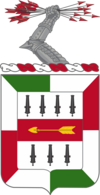5th Infantry Regiment (United States)
| 5th Infantry Regiment | |
|---|---|

Coat of arms
|
|
| Active | 1808–present |
| Country |
|
| Branch |
|
| Type | Infantry |
| Nickname(s) | Bobcats |
| Motto(s) | "I'll Try, Sir" |
| Engagements |
War of 1812 Mexican–American War Civil War Indian Wars Philippine–American War World War II Korean War Vietnam War Global War on Terrorism |
| Battle honours | Presidential Unit Citation 2 |
| Insignia | |
| Distinctive unit insignia |
 |
| U.S. Infantry Regiments | |
|---|---|
| Previous | Next |
| 4th Infantry Regiment | 6th Infantry Regiment |
The 5th Infantry Regiment (nicknamed the "Bobcats") is an infantry regiment of the United States Army that traces its origins to 1808.
The 5th Infantry Regiment was created by an Act of Congress of 3 March 1815, which reduced the Regular Army from the 46 infantry and 4 rifle regiments it fielded in the War of 1812 to a peacetime establishment of 8 infantry regiments (reduced to 7 in 1821). The Army's current regimental numbering system dates from this act.
Six of the old regiments (4th, 9th, 13th, 21st, 40th and 46th) were consolidated into the new 5th Regiment, which was organized on 15 May 1815 under the command of Colonel James Miller. The current 5th Infantry traces its actual origins to the oldest of these regiments, the 4th, which was organized in May–June 1808. After three years' garrison duty in New England, the 4th assembled near Philadelphia in the spring of 1811. From there it proceeded by way of the Ohio and Wabash rivers to Vincennes, Indiana Territory, reporting to the territorial governor, William Henry Harrison, who assembled a force of volunteers and militia around the 4th. They proceeded into north central Indiana to confront the forces of the Shawnee leader Tecumseh and his brother Tenskwatawa, the Prophet, who attacked on the morning of 7 November in the Battle of Tippecanoe, where they were soundly defeated by U.S. forces.(Previously the old 4th US Infantry had served as the 4th Sub-Legion in Anthony Wayne's Legion of the United States which had fought at the Battle of Fallen Timbers in 1794).
In the spring of 1812, the 4th, commanded by then-Lieutenant Colonel Miller, was ordered to report to Brigadier General William Hull, commander of forces in the Northwest. They reached his headquarters at Detroit on 6 July, two days after being notified of the declaration of war. A week later, Hull's force crossed into Upper Canada, forming a base at Sandwich. On 9 August, marching south to rendezvous with a supply train from Ohio, the 4th charged and broke a British-Indian force at the Battle of Maguaga. A week after that, Hull surrendered Detroit and his entire command, including the 4th, to an inferior force of British, Canadians and Indians. The 4th marched into captivity at Quebec city where the troops spent a month aboard prison ships in the St. Lawrence River before being exchanged on 29 October. The 4th lost 30 more men during the month's voyage from Quebec to Boston.
...
Wikipedia
